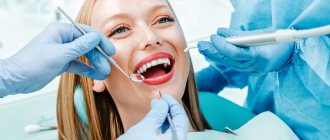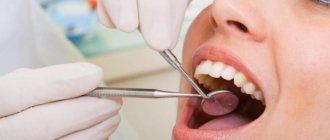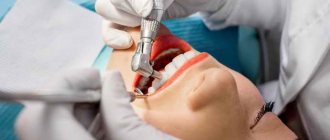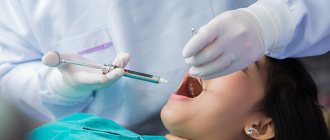Is it possible to get implants for HIV? When is it possible? When is it not possible? Failures during implantation What methods are suitable ROOTT implants for HIV Recommendations Can implantation be refused? Is it worth hiding the status Alternatives Risk of infection during implantation
Acquired immunodeficiency syndrome (AIDS) is the last stage of HIV infection. The body's ability to resist infections and diseases rapidly decreases, which affects organs and systems. Until recently, implantation with HIV was considered impossible. The emergence of one-stage minimally invasive techniques has made it possible to implant implants in people with severe chronic pathologies, incl. HIV and AIDS. The implantation design of RUTT successfully takes root even in patients diagnosed with immunodeficiency or hepatitis.
Is it possible to get implants for HIV?
The human immunodeficiency virus (HIV) gradually destroys the immune system, using its resources to replicate new viral particles. At a certain point, the body's resistance decreases to a critical level. An HIV-infected patient develops severe illnesses that are rare in people with normal immunity. They are called opportunistic or AIDS-indicative.
Implantation is a surgical intervention that requires strength to heal tissue and resist bacterial processes in the oral cavity. In immunodeficiency states, the likelihood of developing postoperative complications and rejection of the artificial root increases.
Not so long ago, HIV infection was a contraindication to implantation. With the advent of one-stage techniques, the list of contraindications has been reduced - immunodeficiency is no longer an obstacle to surgery.
HIV infection in dentistry. Issues of prevention.
Due to the continuing increase in the prevalence of HIV infection, the likelihood of a dentist encountering HIV-infected patients is constantly increasing. Many of these patients may have varying oral manifestations of the disease. Dental health workers cannot refuse to perform their professional duties to AIDS and HIV-infected patients. This will require dentists to know not only the symptoms of oral and periodontal disease, but also the basic principles of HIV prevention.
During dental procedures, damage to the oral mucosa and bleeding are inevitable. In this case, infection of medical instruments, casts, prostheses occurs, and aerosols containing blood and saliva may be dispersed when using high-speed dental units. At a dentist's appointment there may be patients who do not know or are hiding their disease, patients in the incubation stage, who can become a source of infection for other patients and for the staff of the medical institution.
Medical personnel in dental offices and departments belong to the occupational risk group. To prevent infection of personnel during dental procedures, the dentist must know the routes and factors involved in the transmission of HIV, and the provision of dental care must be carried out in compliance with the necessary precautions and with strict adherence to the rules of disinfection and sterilization of medical and dental instruments.
The most common malignant disease of the oral cavity is:
- Kaposi's sarcoma;
- Angular cheilitis caused by the fungus Candida albicans;
- Erythematous candidiasis;
- Pseudomembranous candidiasis;
- HIV gingivitis (linear gingival erythema);
- Necrotizing gingivitis and periodontitis;
- Herpetic ulcers due to HIV infection;
- "Hairy" leukoplakia;
- The wart is viral;
- Aphthous ulcerations;
- B-cell (non-Hodgkin) lymphoma.
HIV infection is a disease caused by the human immunodeficiency virus - an infectious chronic disease characterized by a specific lesion of the immune system, leading to its slow destruction until the formation of acquired immunodeficiency syndrome (AIDS), accompanied by the development of opportunistic infections and secondary malignant neoplasms. AIDS is a condition that develops against the background of HIV infection and is characterized by the appearance of one or more diseases classified as AIDS-indicative.
The source of HIV infection is people infected with HIV at any stage of the disease, including the incubation period. • Mechanism and factors of transmission. • HIV infection can be transmitted through both natural and artificial transmission mechanisms.
The natural mechanism of HIV transmission includes:
- • Contact, which occurs primarily during sexual intercourse (both homo- and heterosexual) and when the mucous or wound surface comes into contact with blood.
- • Vertical (infection of a child from an HIV-infected mother: during pregnancy, childbirth and breastfeeding.)
The artificial (artificial) transmission mechanism includes:
- • Artificial for non-medical invasive procedures , including:
- intravenous drug administration (use of syringes, needles, other injection equipment and materials),
- tattooing,
— when performing cosmetic, manicure and pedicure procedures using non-sterile instruments.
- • Artificial for invasive interventions in health care facilities:
- during transfusion of blood, its components,
- organ and tissue transplantation,
- use of donor sperm, donor breast milk from an HIV-infected donor,
— through medical instruments for parenteral interventions, medical products contaminated with HIV and not processed in accordance with the requirements of regulatory documents.
It can be said with absolute certainty that HIV is not transmitted by mosquitoes, mosquitoes, fleas, bees and wasps. HIV is not transmitted through casual contact. Not a single case of infection through saliva and tear fluid containing blood has been described. Since HIV is not transmitted through saliva, you cannot become infected by sharing glasses, forks, sandwiches or fruit. According to leading experts, contact with intact skin of infected biological fluids (for example, blood) is not enough to transmit the virus.
The main factors of pathogen transmission are human biological fluids:
- • blood,
- • blood components,
- • sperm,
- • vaginal discharge,
- • breast milk.
The main population groups at risk of contracting HIV infection are:
- • injection drug users (IDUs),
- • commercial sex workers (CSWs),
- • men who have sex with men (MSM).
The group at increased risk of contracting HIV includes: clients of sex workers, sexual partners of IDUs, medical workers, including dentists, prisoners, street children, people with a large number of sexual partners, migrating segments of the population (truck drivers, seasonal workers, including including foreign citizens working on a rotational basis and others)
The incubation period for HIV infection is the period from the moment of infection until the body’s response to the introduction of the virus (the appearance of clinical symptoms or the production of antibodies) is usually 2-3 weeks, but can last up to 3-8 months, sometimes up to 12 months. During this period, antibodies to HIV are not detected in the infected person, and therefore the risk of transmission of infection from him in nosocomial foci, including through transfusion of blood and its components, increases.
Stages of HIV infection:
- • acute phase (from 1-5 days to 6 months)
- • latent infection or subclinical stage (from 2 to 10 years)
- • stage of manifest manifestations (prev. AIDS and AIDS).
Acute HIV infection.
In 30-50% of infected people, symptoms of acute HIV infection appear, which is accompanied by various manifestations: fever, lymphadenopathy, erythematous maculopapular rash on the face, trunk, sometimes on the extremities, myalgia or arthralgia, diarrhea, headache, nausea and vomiting, enlarged liver and spleen , neurological symptoms. These symptoms vary in severity. In rare cases, severe secondary diseases may develop already at this stage, leading to the death of patients. During this period, the frequency of referrals of infected people to healthcare facilities increases; the risk of transmission of infection is high, due to the large amount of virus in the blood.
Subclinical stage.
The duration of the subclinical stage averages 5-7 years (from 2 to 10 years, sometimes more), there are no clinical manifestations other than lymphadenopathy. At this stage, in the absence of manifestations, the infected person remains a source of infection for a long time. During the subclinical period, HIV continues to multiply and the number of CD 4 lymphocytes in the blood decreases.
Stage of secondary diseases.
Against the background of increasing immunodeficiency, secondary diseases (infectious and oncological) appear. Initially, these are predominantly lesions of the skin and mucous membranes, then organ and generalized lesions, leading to the death of the patient. Namely: pulmonary tuberculosis extrapulmonary tuberculosis unmotivated weight loss (more than 10% in 6 months) Pneumocystis pneumonia recurrent severe radiologically confirmed pneumonia (2 or more episodes per year) CMV retinitis + colitis infection caused by the herpes simplex virus (chronic or persistent for 1 month or more) HIV-associated cardiopathy, HIV-associated nephropathy, encephalopathy, Kaposi's sarcoma and HIV-associated tumors. toxoplasmosis cryptosporidiosis cryptococcal meningitis progressive multifocal leukoencephalopathy. disseminated fungal infections, non-tuberculous mycobacterial infections or disseminated atypical mycobacteriosis
Laboratory diagnosis of HIV infection is based on the detection of antibodies to HIV and viral antigens. • The standard method for laboratory diagnosis of HIV infection is the determination of antibodies/antigens to HIV using ELISA. To confirm the results, confirmatory tests are used (immune, linear blot).
Diagnostic algorithm for testing for the presence of antibodies to HIV:
- • Stage 1 (screening laboratory).
- • Stage 2 (reference laboratory).
- • Stage 3 confirmatory test (immunoblot)
Stage 1 (screening laboratory).
If a positive result is obtained in the ELISA, the analysis is carried out sequentially 2 more times (with the same serum and in the same test system). If two positive results are obtained from three ELISA tests, the serum is considered primary positive and is sent to the reference laboratory (HIV Diagnostic Laboratory of the Center for Prevention and Control of AIDS) for further research.
Stage 2 (reference laboratory).
The initially positive serum is retested by ELISA in a second test system from another manufacturer, which differs from the first in the composition of antigens, antibodies or test format chosen for confirmation. If a negative result is obtained, the serum is retested in a third test system from another manufacturer, which differs from the first and second in the composition of antigens, antibodies or test format.
If a negative result is obtained (in the second and third test systems), a conclusion is issued about the absence of antibodies to HIV. If a positive result is obtained (in the second and/or third test system), stage 3 is carried out
Stage 3 confirmatory test (immunoblot) (search for antibodies to individual antigens of the core, shell, and enzymes of the virus).
Samples in which antibodies to 2 of 3 HIV glycoproteins (env, gag, pol) are detected are considered positive in the immunoblot. Sera are considered negative (negative) in which no antibodies are detected to any of the HIV antigens (proteins) or there is a weak reaction with protein p 18. Sera are considered undetermined (doubtful) in which antibodies to one HIV glycoprotein and/or any proteins are detected. HIV. If a negative and questionable result is obtained in an immune or line blot, it is recommended to examine the serum after 3, 6, 12 months.
One of the most important problems in HIV testing is the so-called diagnostic window period. This is the period that elapses from the moment of HIV infection until a detectable level of antibodies appears. As a rule, this is the incubation period (from the moment of infection to 6 months). • Taking into account this phenomenon, difficulties arise when examining donated blood from people who are in the mentioned period of HIV infection. Therefore, in most countries of the world, a system of using blood only after it has been stored for 3-6 months has been introduced in order to carry out mandatory re-examination for HIV infection of donors of these doses of blood and its components.
Testing for HIV infection is carried out voluntarily, except in cases where such testing is mandatory. The following are subject to mandatory medical examination for HIV infection: Donors of blood, blood plasma, and other biological fluids, tissues and organs each time donation material is taken; Doctors, paramedical and junior medical staff of centers for the prevention and control of AIDS Medical workers in surgical hospitals (departments) Persons undergoing military service and entering military educational institutions Foreign citizens and stateless persons when applying for a citizenship permit or permit residence.
All instruments and products that come into contact with the wound surface, blood or injectable drugs, as well as certain types of medical instruments that during operation come into contact with the mucous membrane and can cause damage to it are subjected to sterilization: dental instruments: tweezers, probes, spatulas, excavators, pluggers , smoothers, crown removers, skellers, dental mirrors, burs (including diamond-coated) for all types of tips, endodontic instruments, pins, dental discs, cutters, separating metal plates, matrix holders, trays for taking impressions, instruments for removing dental plaque , periodontal surgical instruments (curettes, hooks of various modifications, etc.), instruments for filling tooth canals (pluggers, spreaders), carpule syringes, various types of forceps and nippers for the orthodontic office, vacuum cleaners; ultrasonic handpieces and attachments for them, handpieces, removable micromotor sleeves for mechanical handpieces, cannulas for a dental plaque removal device; surgical instruments: dental forceps, curettage spoons, elevators, chisels, instrument sets for implantology, scalpels, forceps, scissors, clamps, surgical smoothers, suture needles; trays for sterile medical products, instruments for working with sterile material, including tweezers and containers for their storage.
Workplaces are provided with extracts from instructional and methodological documents, first aid kits for emergency prevention in emergency situations.
All medical instruments (as well as dishes, linen, devices, etc.) contaminated with blood, biological fluids, and also in contact with mucous membranes, immediately after use are subject to disinfection in accordance with the order of the Ministry of Health of the Republic of Belarus dated April 2, 1993 No. 66 “On measures to reduce the incidence of viral hepatitis in the Republic of Belarus” and other regulatory documents. Disinfection regimes are similar to those used for the prevention of infection with hepatitis B, C, D.
When carrying out manipulations associated with violating the integrity of the skin, mucous membranes, and also not excluding the splashing of biological fluids during autopsy of corpses, conducting laboratory tests, processing instruments, linen, cleaning, etc., medical workers and technical personnel must use personal protective equipment (surgical gown, mask, goggles or screen, waterproof apron, sleeves, gloves) to avoid contact of the patient’s blood, tissues, biological fluids with the skin and mucous membranes of the personnel. The approach to the use of protective clothing should be differentiated, taking into account the degree of risk of HIV infection.
Medical workers with injuries (wounds) on their hands, exudative skin lesions, and weeping dermatitis are excluded from medical care for patients and contact with care items for the duration of their illness.
Measures for wounds, contact with blood, and other biological materials of patients. Any damage to the skin, mucous membranes, or contamination of them with biological materials from patients during the provision of medical care should be qualified as possible contact with material containing HIV or another agent of an infectious disease.
If contact with blood or other liquids occurs with a violation of the integrity of the skin (injection, cut) , the victim must:
- remove gloves with the working surface facing inward;
- squeeze blood out of the wound;
- treat the damaged area with one of the disinfectants (70% alcohol, 5% tincture of iodine for cuts, 3% hydrogen peroxide solution for injections, etc.);
- wash your hands under running water and soap, and then wipe with 70% alcohol;
Orthopedic dentist, 1st category
Verevkin Dmitry Anatolievich
In what cases is implantation possible?
Preparation for implantation involves a comprehensive examination, including a number of blood tests, including the number of CD4 lymphocytes and viral load. These are two tests that determine how many copies of HIV are in the patient's blood and the state of the immune system.
Implantation is performed when the CD4 cell count is relatively high and there are no adverse symptoms.
- If the CD4 count is more than 500, the risk of complications is the same as in patients without immunodeficiency.
- When the CD4 cell count is 450-400, the likelihood of implant rejection is increased, but surgery can be done.
- At levels of 300 and below, surgery is postponed and antiretroviral therapy is continued until stable levels are achieved.
The doctor plans treatment on an individual basis. It is possible that he will recommend taking the test again or waiting with the operation until the indicators are restored to normal levels.
Education issue
Lebedev states: “It’s enough to ask specialists at some cosmetology seminar: “What is viral load?”, and they won’t answer you. They just don't know this term. Hence the problems. Their knowledge regarding HIV is equal to that of ordinary people who do not have a medical education.” “Now I want to address cosmetologists: don’t you think it would be better not to intimidate patients, not to scare them away from you, but, on the contrary, to form trusting relationships with them so that they do not hide their diagnoses from you? Because it is then that the cosmetologist will be able to guide the patient in the right direction, even if the patient is unfavorable,” the specialist concludes.
According to Lebedev, when a patient comes to him and says that he has HIV, the surgeon clarifies whether he is taking antiviral therapy and what his viral load is. If a patient does not undergo treatment and his viral load is high, Lebedev does not refuse him surgery, but first suggests that he take care of his health and only then come to him. “A patient who wants to improve his appearance is a person who wants to love himself, and we can help him with this. He is not to blame for his diagnosis, it just happened that way, and our task is to help him cope with psychological pressure and alienation, to improve his quality of life,” the specialist sums up.
In what cases should dental implants not be placed?
If the CD4 lymphocyte count is below 350, implantation is not performed. Immunodeficiency states are accompanied by impaired tissue regeneration. With a sharply reduced IS, there is a high risk of fungal and bacterial microflora growing along the implant. Those. the likelihood of peri-implantitis and implant rejection increases.
If the patient, in addition to HIV infection, has additional diseases related to contraindications, the installation of implants becomes impossible.
In case of pathologies included in the list of relative contraindications, the operation is postponed for a more favorable period.
Absolute contraindications
- Decompensated diabetes mellitus;
- severe cardiovascular pathologies;
- open form of tuberculosis;
- diseases of the blood and hematopoiesis;
- oncology;
- condition after radiation, chemotherapy;
- allergy to anesthesia;
- systemic pathologies (lupus erythematosus, aphthous stomatitis, etc.);
- some diseases of the central nervous system (neuroses, psychoses, dementia, schizophrenia, paranoia);
- severe form of hypo- and hyperthyroidism, pathology of the adrenal glands, pituitary gland;
- connective tissue lesions with manifestations in the maxillofacial area;
- pathologies of bone tissue (dysplasia, osteopathy, osteoporosis, osteonecrosis);
- metal intolerance.
Relative contraindications
- Diseases of the temporomandibular joint;
- increased abrasion of tooth enamel;
- bite pathologies;
- arthrosis;
- bruxism;
- smoking abuse;
- past drug use;
- venereal diseases;
- not sanitized oral cavity - caries, gingivitis, periodontitis, periodontal disease;
- poor oral hygiene;
- pregnancy, lactation.
Dental implants – main contraindications
Dental implants are not always a solution that can be used by a patient who consults an implantologist. The most common contraindications to implant installation are chronic diseases affecting the skeletal system or immunity. The dentist should be informed of any medical conditions that may complicate the procedure or lead to complications. It is mandatory to collect an anamnesis when planning a procedure, which includes not only a conversation with the patient, but also checking the condition of the oral cavity and performing a number of tests.
Is it always HIV status that can lead to implantation failure?
Rejection of dental implants is possible due to various reasons; the patient’s HIV status is in penultimate place . The main reasons for artificial root rejection:
- Medical error (unprofessionalism of the implantologist) - incorrect calculation of the place where the titanium root should be implanted, incorrect installation of the implant relative to the level of the alveolar ridge.
- Poor-quality implantation system - the process of osseointegration depends on the quality of the material from which the artificial root is made. Since tissue regeneration is reduced in immunodeficiency, the quality of the implant is of paramount importance for its normal fusion with the bone.
- Failure to comply with doctor's recommendations regarding postoperative care on the part of an HIV-infected patient. With poor hygiene, the risk of developing peri-implantitis and titanium root rejection increases 5-7 times.
- Exacerbation of HIV disease - the immune system cannot cope with its responsibilities, medications have almost no effect, post-operative wounds do not heal well, inflammation develops in the implantation area, and the implant begins to be rejected.
The risk of infection or rejection is also present in healthy patients. But with immunodeficiency it is higher. Difficulties are possible at any stage of treatment. There is no need to plan implantation for HIV infection with complications due to the risk of undesirable consequences.
"Black Marks"
In 2022, the head of the St. Petersburg Positive Wave Foundation, Sergei Shagaleev, told the AIDS.CENTER website: his organization alone that year received about forty complaints from people with HIV about the refusal of medical workers to provide them with this or that service. For the majority of identified cases, fund employees submitted applications to Roszdravnadzor and the regional health authority. But the forty refusals mentioned are just the tip of the iceberg.
In January of the same year, the Yekaterinburg agency URA.ru published a letter from one of its readers, which described how a patient who came to the dental clinic found a “B-20” mark on the front side of his medical card, indicating that he was infected HIV. The material released by the publication was entitled: “At the Yekaterinburg clinic, patients with HIV are given ‘black marks’.” And this is not exaggeration.
Almost all questionnaires that a client of a dental office has to fill out if he comes there for the first time contain a paragraph where the client is asked for his HIV status. According to Positive Wave, about 20% of dental clinics in St. Petersburg, if the client honestly admitted HIV and checked the required box, at least once refused HIV-positive patients already at the stage of trying to make an appointment. “Generally speaking, this is not the exception, but rather the rule. People with HIV usually either don’t talk about their status at all, or next time they go where they won’t refuse,” Shagaleev stated then. In the two years since that interview, judging by the testimony of many clients of the AIDS.CENTER fund for people living with HIV, the situation neither in Moscow nor in the northern capital has changed radically.
Implantation methods - are they all suitable?
When using the classic two-stage protocol, the probability of engraftment of the artificial root is low, due to the traumatic nature of the intervention. A weak immune system will not be able to cope with wound healing after the implantation procedure or repeated incision to fix the crown. Therefore, the method of choice is basal implantation.
- The technology involves installing a titanium root through a micro-puncture of the gums with immediate loading of the prosthesis. The operation is performed in one stage; the implant root and abutment form a single structure.
- The use of special models of implants implanted into deep bone layers that are not subject to inflammation and atrophic processes provides high primary stability and rapid osseointegration.
- Titanium roots are implanted into the lateral zones at an angle, bypassing the sinuses, nerve plexuses, and large blood vessels.
- Installation of basal implants is the best option for severe chronic pathologies, including immunodeficiency and hepatitis.
Minimally invasive surgery does not involve cutting the gum, drilling the bone, or placing sutures. Postoperative rehabilitation proceeds quickly, with minimal discomfort for the patient.
The ROOTT Clinic is one of the few dental centers in Russia specializing in dental implantation methods with immediate loading. Our doctors have been working with the basal protocol for many years. Thanks to the combination of protocols in one design, we restore teeth in record time, even in patients with a complicated history.
ROOTT dental implants are the best choice for patients with HIV
ROOTT implant structures are made of biocompatible titanium with an antimicrobial surface. When the package is opened, titanium reacts with oxygen and a hydroxyapatite film is formed on the surface of the implant. Hydroxyapatite is an element that makes up bone tissue. This increases the chance that the jawbone will not reject the titanium root. The polished surface prevents the accumulation of bacterial plaque in the cervical area, which minimizes the risk of peri-implantitis.
Recommendations after surgery
After implantation, you must scrupulously follow your doctor’s recommendations regarding oral care immediately after the intervention and beyond. This applies to all patients, but HIV-positive patients must especially strictly follow all medical instructions. Post-intervention recommendations include:
- oral care;
- lifestyle changes;
- service in the clinic.
Oral care
- Brush your teeth twice a day, paying attention to the spaces between teeth;
- use dental floss;
- rinse your mouth every time after eating;
- avoid too hard foods (nuts, roasted vegetables);
- Visit your dentist every 6 months for professional hygiene cleaning.
In the early postoperative period (7-10 days), oral antiseptic baths are performed after meals.
General recommendations after surgery
- Limit sports and physical activity for a month;
- avoid hypothermia or overheating;
- give up alcohol and smoking for at least a month;
- no air travel for 10-14 days;
- carefully sneeze, cough, blow your nose, especially if the implantation was done in the upper jaw;
- Do not skip preventive examinations at the dentist.
After installation of the implants, the doctor will prescribe a short course of antibiotic therapy. Maintaining normal CD-4 cell levels is important, so antiretroviral therapy (if prescribed) should not be ignored.
Dental treatment is safe and convenient
Modern types of anesthesia used in the “22nd Century” clinic allow:
- Carry out most treatment procedures in one clinic visit (which saves the patient’s time);
- Minimize the recovery time after the procedure (usually this requires no more than a day);
- Overcome the fear of visiting a dental clinic (which means responding in a timely manner to the occurrence of dental problems, and not delaying until the last minute, when the disease enters the stage of deep neglect).
Can a doctor refuse implantation?
Refusal is possible in the following situations:
- The implantologist does not know modern treatment protocols and considers HIV an absolute contraindication to implant prosthetics.
- The doctor is afraid of infection because he will have to come into contact with the patient’s blood.
- CD4 cell count is too low.
- For medical reasons (in addition to immunodeficiency, there are a number of complications).
Positive HIV status is not a reason to refuse medical care . According to Article 124 of the Criminal Code of the Russian Federation, a doctor who evades his duties without a valid reason is liable, including restriction of freedom.
Main stages of the disease
The stages of HIV are divided into the following:
- incubation This is the stage at which infection and subsequent multiplication of the virus in the blood occurs. It lasts up to six weeks, sometimes less. Even if infected, at this stage a person will not see obvious signs, and a blood test will not show that there are antibodies in the blood;
- primary. The first signs of infection may already appear here. The second stage lasts for 3 weeks - at this time antibodies appear, the virus is determined in the laboratory;
- subclinical. The first sign of the disease appears - enlarged lymph nodes. The patient feels completely healthy and does not complain about his health;
- the appearance of secondary diseases. The immune system begins to malfunction, causing a variety of diseases to appear: from frequent colds and candidiasis to pneumonia, tuberculosis;
- terminal. The stage involves exhaustion (rather rapid and progressive), as well as the subsequent death of the patient.
The stages do not have one correct time frame - they may differ from person to person. For example, HIV-infected people often feel well for years or do not pay attention to small signs. The disease is detected only at the stage of severe deterioration in health or through random tests.
Should you hide your status?
According to the laws of the Russian Federation, the patient is obliged to notify the doctor about his HIV status. In any case, it is better not to hide such information. The doctor carries out treatment according to the general state of health - selects a treatment protocol, implantation design, and effective antibiotic therapy.
Let’s assume that the implantologist does not know about the positive HIV status and prescribes antibiotics in the same dosage as for a healthy patient. Such therapy will not have the desired effect, which will lead to inflammation, peri-implantitis, and, as a consequence, rejection of the artificial root. The doctor must be aware of the possible risk. Health information helps select a treatment regimen that will provide the best outcome for the patient.
Since immunodeficiency states are included in the list of restrictions for implantation, an HIV test is included in a comprehensive diagnosis. Therefore, hiding HIV status from the dentist is problematic.
Vacuum of knowledge
However, this issue is regulated by written rules. Thus, the Decree of the Chief State Sanitary Doctor of the Russian Federation dated May 18, 2010 N 58 (as amended on June 10, 2016) “On approval of SanPiN 2.1.3.2630-10 “Sanitary and epidemiological requirements for organizations engaged in medical activities”” indicates that dental handpieces must be sterilized after each patient.
This is also evidenced by modern instructions on the correct and safe processing of dental handpieces. The Kemerovo correspondent for AIDS.CENTER conducted a small experiment: she specifically walked through the city’s dental offices to check how these documents work. It turned out that there was no way. When a woman sat down in a chair and asked uncomfortable questions, the answer, as a rule, in most places was the already familiar “We treated it,” which in practice often meant: they wiped the top twice with a cotton swab containing chloramine.
However, there is no need to panic. Professor of the Department of Infectious Diseases and Epidemiology of the Moscow State Medical University named after A. I. Evdokimov Irina Shestakova answers a question on our site that it is quite difficult to really assess the likelihood of such an infection. And the risk is not as great as it might seem at first glance.
Alternatives
If implantation cannot be performed, the patient is offered alternative options:
- Dental bridges are a reliable method of prosthetics, but require depulpation and grinding of healthy teeth that act as a support for the prosthetic structure.
- Removable dentures are the simplest method of restoring dentition. However, it does have disadvantages. Does not stop bone atrophy, restores chewing function by 60%. Removable dentures cannot be used in the presence of opportunistic diseases of the oral cavity (aphthous stomatitis, exfoliative cheilitis, Kaposi's sarcoma, etc.).
- Mini-implants are characterized by rapid healing, securely fix a removable denture in the mouth, but cannot withstand increased loads during chewing.
ROOTT implantologists recommend mini-implantation and removable prosthetics as a temporary solution during antiretroviral therapy. When stable CD4 cell counts and an undetectable viral load are achieved, basal implantation is performed.
HIV treatment
Treatment boils down to prescribing antiretroviral therapy. The patient is given a medication regimen - and it must be followed as precisely as possible, without deviating from the program. Otherwise, the virus may develop resistance to treatment and cannot be further suppressed.
Indicators of quality treatment are a decrease in the viral load, as well as an increase in CD4+ cells in the blood, which indicates the activity of the immune system.
Medicines for treatment are issued in medical institutions, patients are registered and receive medications free of charge, in accordance with the established procedure. Information about the disease is confidential - it is not sent to work, place of study or other places. The patient has the right to keep it secret (if this is not provided for in separate work contracts).
If the rules for taking therapy are followed, the virus in the blood gradually decreases; over time, the patient becomes completely safe for his sexual partner and is not able to infect anyone.











